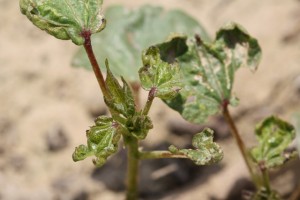The phone has been ringing regularly the last few days with reports of fairly high thrips numbers, mostly adults, on seedling cotton. Most of our cotton is less than the two leaf stage. I’m not too surprised considering the wheat is drying down just as our cotton is emerging. Averages of 2 – 8 thrips per plant are being reported, with a few people also complaining about injury beginning to show up. One or two have complained that Cruiser does not seem to be performing as well as Gaucho, which is something that was observed last year in many circumstances.
I do not get too concerned about seeing an average of one thrips per plant, even on very small cotton, unless immatures are already present. However, treatment would be suggested on cotton with less than two true leaves when multiple adult thrips are present per plant or an average of one thrips is present per plant and some immatures also present. Remember – the presence of immatures indicates that seed treatments are no longer providing protection, and we usually start seeing immatures 18-21 days after planting (assuming an insecticide seed treatment was used). Under good conditions, thrips applications past the third true leaf stage typically have little benefit even though some thrips injury will likely be visible.
UT recommends the following insecticides:
- Acephate or Orthene (90 or 97%) at 0.20 – 0.25 lbs product per acre. Higher rates usually do not improve control.
- Bidrin 8E at 2 – 3.2 oz product per acre
- Dimethoate 4E at 4 – 8 oz product per acre (6 oz is usually the x – rate)
- Radiant SC * – 1.5 – 3.0 oz product per acre
* Radiant SC is one of the few insecticides where adding an adjuvant consistently improves control. Crop oil or an NIS is needed. Most folks will use 1.5 oz per acre to save on cost, but this rate is not recommended unless an adjuvant is used.

Is one product better than the other? It depends on which thrips are present and you should also consider injury potential when mixing with herbicides.
- Acephate is an effective standard. The rates above provide consistent control unless western flower thrips (WFT) are also present. Fortunately, western flower thrips are usually a very small component of the thrips complex in Tennessee, and I’ve had no reports yet this season (although it is early). In a survey done at Jackson in 2009 and 2010, WFT were not detected. Rather, tobacco thrips, onion thrips and soybean thrips were the most common species. Higher rates of acephate (0.5 lb ai/acre) would be an option if you are dealing with WFT, but Radiant SC would be a better choice.
- Bidrin and Dimethoate also provide consistent control of thrips, again with the exception of western flower thrips. Dimethoate in particular may cause some injury. I typically do not recommend either product if they will be tank mixed with Liberty and/or products containing Dual. However, I would be much less concerned with these tank mixes on Liberty Link cotton where tolerance to Liberty applications is much higher than we see on WideStrike varieties such as Phytogen 375.
- Radiant SC is a relatively new insecticide from Dow AgroSciences. It is more expensive than the other choices. Its strength is control of WFT (if an adjuvant is used). It is closely related to Tracer, and thus, has little impact on most beneficial insects. So it may be a good choice in areas that historically had trouble with early season spider mites. I do not have great data to prove this. In fact, western flower thrips like to eat spider mites. It is conceivable that taking out populations of WFT could flare spider mite infestations ….. a damned if you do and damned if you don’t scenario ..… but you have to take care of existing problems as opposed to one you might have later.
My counterparts and I have done a lot of work on the value of foliar thrips applications on cotton with either a Cruiser or Gaucho seed treatment. These data suggest little or no impact on yield in most circumstances (there are exceptions). They also indicate that sprays made at or before the second true leaf stage typically have the most value. Multiple applications for thrips are RARELY justified on cotton having an insecticide seed treatment. The moral ….. make your first application early as needed based on growing conditions and thrips populations. Avoid multiple sprays except in extreme situations because these often create more problems than they cure by flaring spider mite or aphid populations.


One thought on “Thrips Management in Cotton”
Comments are closed.